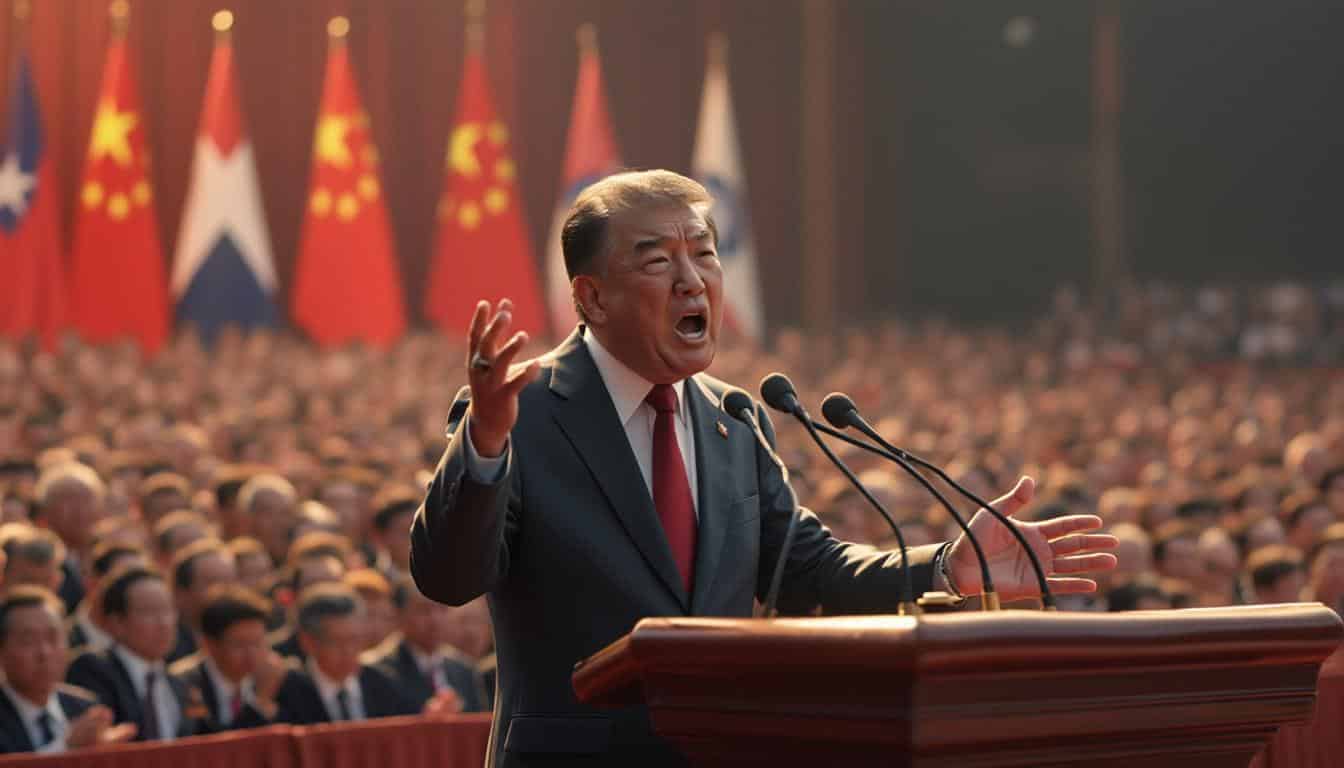The United States Secretary of Defense, Pete Hegseth, has made a vigorous call to his allies to increase their defense spending.
In a historic speech delivered at the Shangri-La Dialogue in Singapore, he warned that China could represent an imminent military threat.
This stance marks a significant turning point in American policy towards Asia.
Hegseth emphasizes the necessity for American allies not to rely solely on the United States for their regional security, but to take on a greater share of their own defense. He highlights the strategic priority of the Indo-Pacific for Washington, reminding that the United States will continue to bolster its military presence in the western Pacific. He also criticizes the instability caused by the lack of Chinese military engagement, particularly in the South China Sea and around Taiwan. In conclusion, Hegseth reaffirms that the United States is ready to defend its allies resolutely if needed.

During the recent Shangri-La Dialogue in Singapore, the American Secretary of Defense, Pete Hegseth, marked a significant turning point in the United States’ posture towards China. In a long-anticipated speech, Hegseth clearly signaled a rise in tensions and a redefinition of American strategic priorities in the Asia-Pacific.
Table des matières
ToggleWhy does Hegseth view China as an imminent threat?
Hegseth unequivocally stated that China poses a real and imminent threat to regional and global security. This statement starkly contrasts with the previous positions of American administrations, which minimized the risk of direct conflict with Beijing. According to Hegseth, China’s recent actions in the South China Sea and around Taiwan illustrate an aggressive military strategy aimed at reshaping the balance of power in the region.
This perspective is reinforced by recent technological and military developments. For example, the rise of technologies such as deep sensing allows the U.S. military to better monitor and counter Chinese military capabilities. Furthermore, Hegseth stressed the growing importance of electromagnetic resources in the Pacific, an area where China is heavily investing to dominate military and civilian communications.
What are the implications for U.S. alliances in the Asia-Pacific?
In light of this perceived threat, Hegseth called on American allies to increase their defense spending. He insisted that U.S. allies must take on a greater share of the military burden, rather than relying entirely on American forces. This request fits into a strategy aimed at reinforcing collective resistance against Chinese expansion.
In addition, Hegseth talked about the need for increased collaboration in technological defense. Initiatives such as the creation of advanced detection networks and intelligence sharing are becoming essential to meet the challenges posed by China. He also mentioned the importance of maintaining a robust military presence in the Pacific, reiterating the U.S. commitment to deploying forces in the region.
This position could influence countries like Australia and Japan to reassess their defense budgets. For example, allied nations have already begun to announce increases in their military spending, although some experts believe these commitments remain insufficient in light of the severity of the current situation. More information on deployment efforts and capacity building can be found in the article on the failure of the Indian radar imaging satellite launch, which demonstrates the technological challenges faced by allied forces.
How does this new American position affect the overall strategy in the region?
Hegseth’s stance redefines American strategy in the Asia-Pacific, placing a greater emphasis on deterrence and military readiness. By openly denouncing China as a threat, the United States seeks to galvanize its allies and partners for a coordinated and strengthened response. This approach comes with a reevaluation of existing alliances and partnerships, aiming to create a united front against Chinese ambitions.
A key aspect of this strategy is the modernization of military capabilities and the implementation of advanced technologies. For example, the development of sophisticated detection systems plays a crucial role in monitoring Chinese military movements and preventing any undesirable escalation. Additional resources in this area, such as deep sensing, are essential to maintain technological superiority.
In parallel, emphasis is placed on diplomacy and multilateral cooperation. The United States is seeking to strengthen ties with regional and international organizations to create a broader coalition capable of effectively countering China’s actions. This approach also includes promoting international standards and rules of conduct in strategic maritime spaces.
What are the international reactions to this speech?
Hegseth’s statements have elicited mixed reactions on the international stage. Some allies have welcomed the call for greater solidarity and increased defense spending, recognizing the need for a collective response to an ambitious China. Others, however, have expressed reservations about the more aggressive rhetoric, fearing it could contribute to an escalation of regional tensions.
Notably, some nations prefer to maintain a balanced relationship with China, seeking to maximize economic benefits while ensuring their security. French President Emmanuel Macron, during an intervention at the same summit, warned against the risk of a “division of the world,” calling for countries to avoid being forced to choose sides. This position highlights the complexity of current international dynamics, where economic and security interests often clash.
In the United States, even within the government, there are divergent opinions. Senator Tammy Duckworth, leading a bipartisan delegation in Asia, criticized Hegseth’s tone, calling it “condescending.” She reiterated the need to support allies without imposing a confrontational rhetoric, underscoring the importance of a more nuanced and collaborative approach.
What are the potential consequences for global security and military spending?
Hegseth’s insistence on increasing defense spending could have significant implications for global security dynamics. By encouraging allies to boost their military budgets, the United States is seeking to create a more resilient defense network capable of addressing various threats. However, this could also lead to an arms race, where nations engaged in such a race constantly seek to outpace their rivals in military capabilities.
Moreover, the redeployment of military resources, as Hegseth has done by redirecting American military assets to the Middle East, can lead to strategic imbalances in other regions. Focusing on the Asia-Pacific might leave some areas less protected, creating vulnerabilities that malicious actors could exploit.
The impact on national budgets might also be felt, with allocations for defense potentially coming at the expense of other essential sectors such as education, health, or scientific research. Particular attention deserves the article on NASA and its warnings about budget deficits, which illustrate how competition for resources can affect national priorities.
What is the expert position on this new strategy?
Experts in international relations and defense have expressed varied opinions on Hegseth’s speech. Some praise the clarity and firmness of his position, arguing that it is a necessary step to counter China’s growing ambitions. Others, however, warn against the risks of escalation and encourage a more balanced approach that combines deterrence and diplomacy.
Analysts also emphasize the importance of continuing to invest in technology and innovation to maintain a strategic edge. Areas such as air threat detection become crucial in this context, requiring considerable expertise and resources to develop effective defense systems. The integration of advanced technologies, such as artificial intelligence and big data, is also seen as essential to anticipating and responding to Chinese military movements.
Furthermore, the economic dimension of the confrontation cannot be ignored. Experts stress the necessity of strengthening economic alliances and promoting resilient supply chains to reduce dependence on China. This strategy aims to limit Beijing’s economic influence while supporting the local economies of allied nations.
What are the next steps for the United States and its allies?
Following Hegseth’s speech, the United States and its allies are at an important strategic crossroads. The next step will likely involve an ongoing reassessment of defense policies and an intensification of military and technological cooperation. Existing alliances, such as NATO, could serve as a model for strengthening partnerships in the Asia-Pacific, integrating new members and expanding areas of collaboration.
Furthermore, the United States may intensify its efforts to modernize its armed forces and those of its allies, focusing on capabilities such as electronic warfare, cybersecurity, and missile defense. The goal is to create an integrated defense network capable of responding quickly and effectively to emerging threats.
Diplomatically, a proactive approach will be necessary to maintain international support and avoid fragmentation of the front against China. This includes regular dialogues with allies, active participation in multilateral forums, and the promotion of international standards that support regional stability and security.
Finally, investments in research and development will play a key role in maintaining technological advancement. Initiatives such as those mentioned in the failure of satellite launches highlight the importance of overcoming technical challenges to ensure sustained military superiority.
#>























